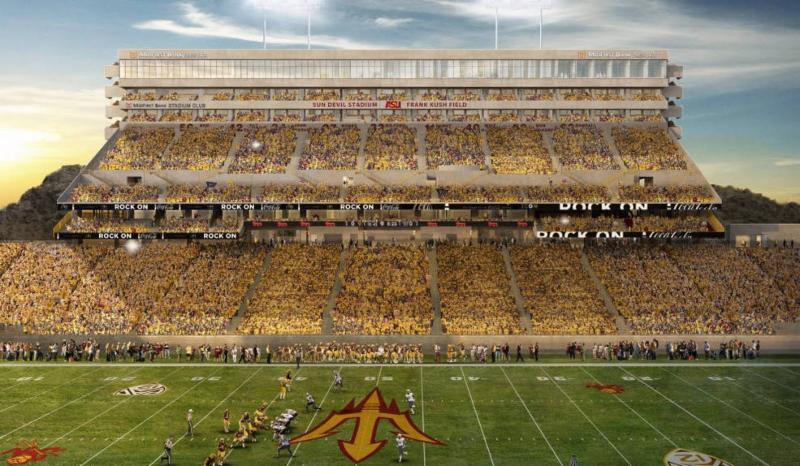The Arizona State University Sun Devils are continuing their renovations to Sun Devil Stadium—which is being transformed into a more modern, intimate, and versatile facility. Phase two of the improvement is well underway, bringing about several facility changes that will aim to improve the fan experience.
Much of the work in phase two of the renovation focuses on Sun Devil Stadium’s west side. As part of a $107 million project, the lower bowl on the west side is being completely rebuilt. The stadium will now feature state-of-the-art seating in both the upper and lower levels with new sections providing legroom and better back support. In addition, these changes will also allow the university to add more premium seating.
Other renovations to the west side of Sun Devil Stadium go beyond the seating bowl by striving to improve accessibility and connectivity. New concourses will be added and placed 20 feet higher than previous walkways, allowing for better airflow throughout the facility. The concourse will also be extended, setting up an eventual connection to the east side—which is slated to be complete before the 2017 season—giving Sun Devil Stadium a 360 degree walkway.
Additionally, the west side will now feature improved WI-FI access, something that has been a priority throughout the renovation.
Similar modifications are being made on the stadium’s north end. The focal point of this work is a new 115,000 square foot student-athlete facility, which will not only serve as a state-of-the-art amenity for players, but provide the opportunity to change the fan experience. Also located on the north end will be a brand new student section, while a patio will be constructed on top of the training facility. This part of Sun Devil Stadium will be open to fans, featuring its own concessions and restrooms.
This phase represents a major step towards the university’s long-term vision for the facility. While Sun Devil Stadium has served the university well in its now 58-year history, it has not been significantly enhanced since the 1980’s, when adjustments were made to accommodate the NFL’s Arizona Cardinals.
Its age, combined with the increasingly-competitive landscape that is college football stadium construction and development, made Sun Devil Stadium ripe for upgrades. And while most of these enhancements take the typical approach of addressing fan amenities as well as investing in better player facilities, the Sun Devils want the stadium to become a year-round destination for the university and the Tempe community at large.
To that end, the university announced last fall the appointment of Colleen Jennings-Roggensack, Executive Director of ASU Gammage and Associate Vice President Cultural Affairs for ASU to oversee non-football events, with president Michael Crow making it clear that increasing Sun Devil Stadium’s viability for additional festivities was a top priority.
In the time since, the university has sought feedback from both members of the Tempe community as well as students. Over the spring, ASU accepted ideas from its design school students, with the winning project suggesting year-round use of the field and concourse for the campus community, as well as the installation of a playground and a beer garden.
The renovation, which completed its first phase before last season, comes at an estimated cost of $256 million, the vast majority of which is expected from revenue generated by the stadium as well as private donations. AZ Central recently reported that private donations to the Sun Devil Stadium project are expected to reach $70 million by the end of this summer, meaning that the university will have achieved in excess of 80% of its original $85 million goal. ASU officials have said that the university does not want to use tuition or taxpayer dollars to pay for the work.
While construction is still ongoing, ASU recently stated that Sun Devil Stadium will be ready for in time for the regular season, which begins on September 3.
Some of the bigger changes around the corner include the east end renovations, a new 100-by-50 foot videoboard on the north end, increased WI-FI access technology, and new basic and premium seating options. Current estimates place seating capacity of the post-renovations Sun Devil Stadium at just below 60,000 spectators, a smaller number than more than 64,000 fans the facility seated during the 2014 season. The third and final round of improvements will take place before the 2017 slate.
This article first appeared in the weekly Football Stadium Digest newsletter. Are you a subscriber? It’s free, and you’ll see features like this before they appear on the Web. Go here to subscribe to the Football Stadium Digest newsletter.



